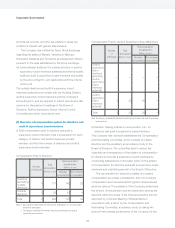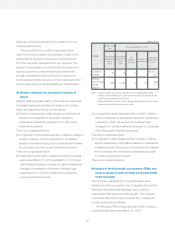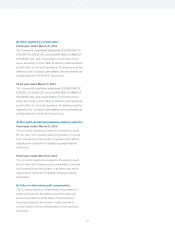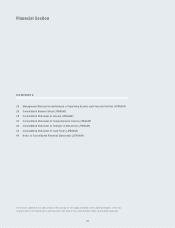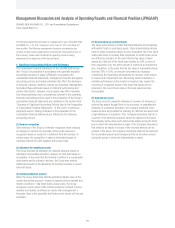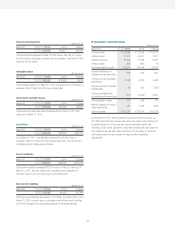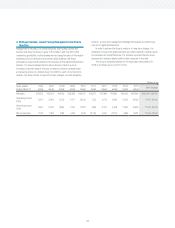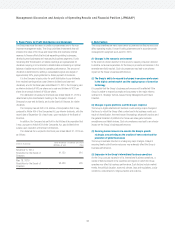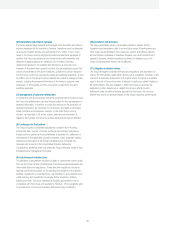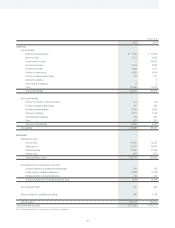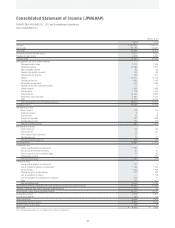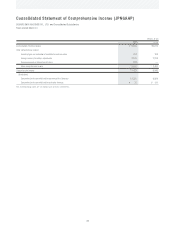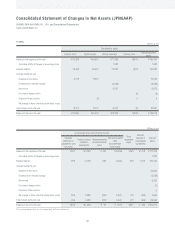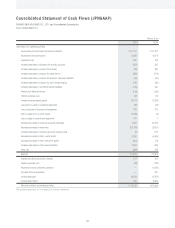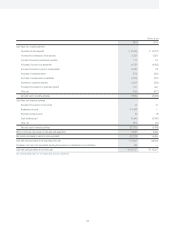Square Enix 2015 Annual Report Download - page 36
Download and view the complete annual report
Please find page 36 of the 2015 Square Enix annual report below. You can navigate through the pages in the report by either clicking on the pages listed below, or by using the keyword search tool below to find specific information within the annual report.
34
5. Basic Policy for Profit Distribution and Dividends
The Group has made the return of profits to shareholders one of its most
important management tasks. The Group prioritizes investments that will
enhance the value of the Group and toward this end maintains internal
reserves to finance efforts that include expanding existing businesses,
developing new businesses and restructuring business segments. Funds
remaining after the allocation of retained earnings are appropriated for
dividends, keeping in mind returns to shareholders and seeking an optimal
balance of stable returns linked to operating performance. The amount of
dividends is determined by setting a consolidated payout ratio target of
approximately 30%, paying attention to stable payment of dividends.
It is the Company’s basic policy for profit distribution to pay dividends
from retained earnings twice a year (interim dividends and year-end
dividends), and for the fiscal year ended March 31, 2015, the Company paid
an interim dividend of ¥10 per share and a year-end dividend of ¥20 per
share for an annual dividend of ¥30 per share.
The distribution of surplus for the fiscal year ended March 31, 2015 is
determined by the shareholders’ meeting or the Company’s Board of
Directors for year-end dividends, and by the Board of Directors for interim
dividends.
The Company has set forth in its Articles of Incorporation that it may,
pursuant to Article 454 of the Companies Act, pay interim dividends, with the
record date of September 30 of each year, upon resolution of the Board of
Directors.
In addition, the Company has set forth in its Articles of Incorporation that
it may, pursuant to Article 459 of the Companies Act, pay dividends from
surplus upon resolution of the Board of Directors.
The dividends from surplus for the fiscal year ended March 31, 2015 are
as follows:
Date of resolution Total dividends
(Millions of yen)
Dividends per share
(Yen)
November 6, 2014
Resolution by the Board of
Directors
¥1,152 ¥10
May 18, 2015
Resolution by the Board of
Directors
¥2,438 ¥20
6. Risk Factors
The Group identifies the items listed below as potential risk factors that could
affect operating results. Forward-looking statements are in accordance with
management’s judgment as of June 30, 2015.
(1) Changes in the economic environment
In the event of a harsh downturn in the economy causing consumer demand
to decline, consumer expenditure for the Group’s products and services in the
entertainment field may fall. Such circumstances may lead to an adverse
impact on the Group’s business performance.
(2) The Group’s ability to respond to changes in consumer preferences
in the digital content market and the rapid progress of innovative
technology
It is possible that the Group’s business performance will be affected if the
Group is unable to respond promptly and accurately to the major reforms
outlined in 4. Strategic Outlook, Issues Facing Management and Future
Direction.
(3) Changes in game platforms and the Group’s response
The Group’s digital entertainment business could undergo major changes in
the forms by which the Group offers content and in its business model as a
result of diversification, the trend toward increasingly advanced functions and
the general transition of platforms for home-use video game consoles,
smartphones and tablet devices. Such circumstances may lead to an adverse
impact on the Group’s business performance.
(4) Securing human resources to execute the Group’s growth
strategies concentrating on the creation of new content and the
promotion of global businesses
The Group’s business structure is undergoing major changes. Delays in
securing ideally suited human resources may adversely affect the Group’s
business performance.
(5) Expansion in the Group’s international business operations
As the Group pursues expansion of its international business operations, a
variety of factors present in the countries and regions in which the Group
operates may affect its business performance. Such factors include market
trends, the political situation, economic climate, laws and regulations, social
conditions, cultural factors, religious factors and customs.
Management Discussion and Analysis of Operating Results and Financial Position (JPNGAAP)


